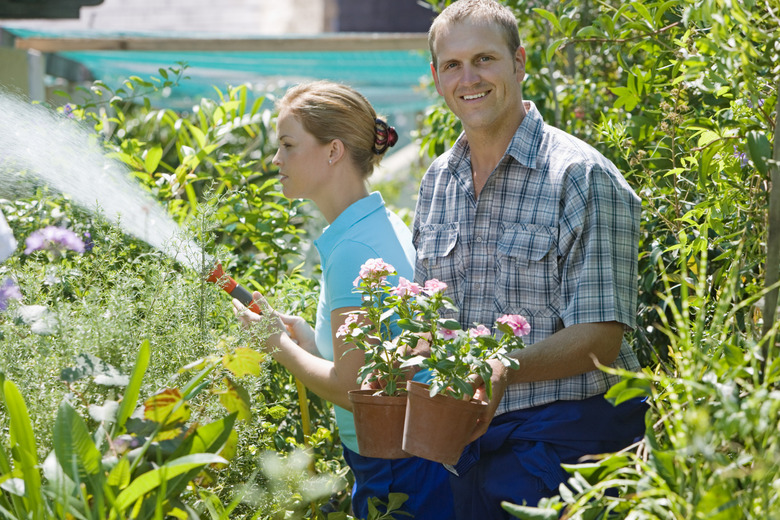Parts Of A Garden Hose
Most garden crops and herbaceous ornamental plants benefit from at least 1 inch of water supplied weekly through some combination of rainfall and supplemental irrigation. One crucial component of most home irrigation systems is the garden hose. Understanding basic garden hose anatomy makes it easier to select the most appropriate hose for a landscape. Many garden hoses, especially older ones, are considered unsafe for drinking water because they may contain heavy metals or harmful chemicals. If a hose is intended for drinking water, food-grade hoses are available.
Tubing
Step 1
Most of the variation between different hoses involves the tubing. Length, hose material and construction vary greatly, influencing cost, flexibility, durability, UV-resistance and temperature tolerance. Two common garden hose diameters are 5/8 inch and 3/4 inch. Hoses with a 3/4-inch diameter can carry more water than smaller tubes but are heavier and tend to cost more. Hoses made out of polyurethane are relatively lightweight and cost-effective but more prone to kinking than rubber or vinyl hoses, which are heavier and tend to cost more but are less likely to have problems with kinking or degradation. High-quality hoses may have several layers, or plies, including a reinforcing mesh layer, and they often come with a warranty.
- Most garden crops and herbaceous ornamental plants benefit from at least 1 inch of water supplied weekly through some combination of rainfall and supplemental irrigation.
- Many garden hoses, especially older ones, are considered unsafe for drinking water because they may contain heavy metals or harmful chemicals.
Hose Ends and Connections
Step 1
Thin metal hose ends are lightweight and common on inexpensive hoses but tend to be dented or bent easily, making it difficult to attach implements or resulting in leaks. Thicker metal hose ends are heavier and usually more expensive but also more durable. Couplings or fittings connect the hose to the water source and are often plastic or brass. Plastic couplings are generally less expensive and easier to tighten and loosen than brass couplings, but they do not last as long as brass fittings. Damaged hose ends or couplings are relatively easy to replace with materials of the same or higher quality. "Y" connectors allow you to attach two hoses to a single water source.
Nozzles and Other Attachments
Step 1
Nozzles or other attachments for the hose end are most directly responsible for delivering water at the preferred rate. Nozzles often feature various settings that allow for different rates and methods of application. Sprinklers attached to a hose end deliver water to a broader area. Shut-off valves allow a gardener to shut off the water flow at the end of the hose rather than back at the spigot or faucet. Some specialized fittings allow you to switch between attachments without first turning off the water at the source.
- Thin metal hose ends are lightweight and common on inexpensive hoses but tend to be dented or bent easily, making it difficult to attach implements or resulting in leaks.
- Nozzles or other attachments for the hose end are most directly responsible for delivering water at the preferred rate.
Additional Considerations
Step 1
Although hose color seems like an aesthetic concern, it can also be very important. A green hose may blend in with the grass well, but this may make it difficult to spot when walking through the landscape, which presents a tripping hazard, or while mowing the lawn. A yellow, orange, black or red hose may be preferable in some cases. There are many additional products that may come with a hose or are purchased as accessories to make it easier to water plants or handle the hose. Hose reels, racks or carts allow for neater storage and easier transport. Some hoses may feature a kink collar designed to prevent kinks. As an alternative to or for use in conjunction with regular garden hoses are soaker and drip hoses, which feature small openings that allow water to slowly seep out of the hose into the soil.
- Although hose color seems like an aesthetic concern, it can also be very important.
- A green hose may blend in with the grass well, but this may make it difficult to spot when walking through the landscape, which presents a tripping hazard, or while mowing the lawn.
